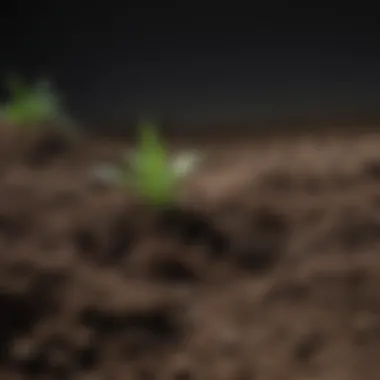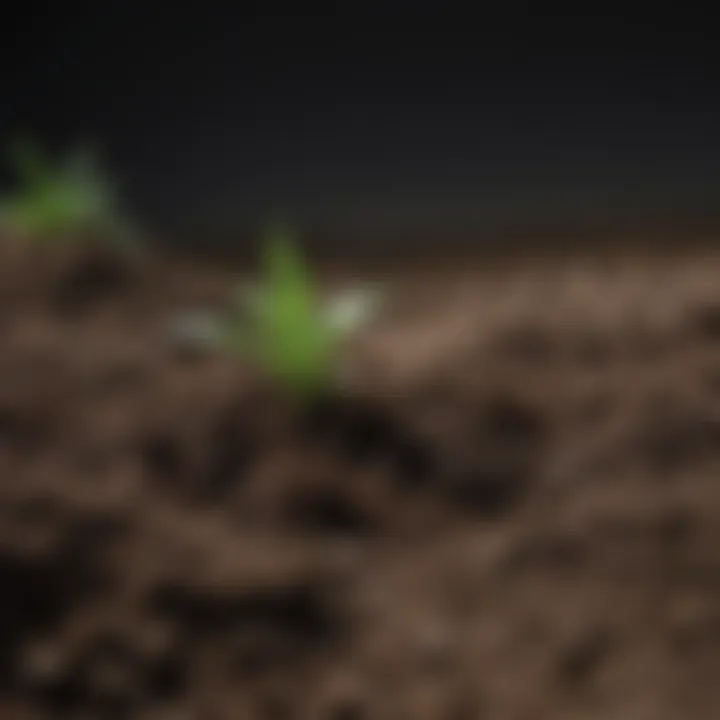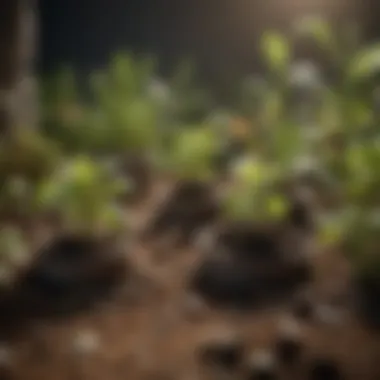Creating a Thriving Backyard Garden: A Step-by-Step Guide


Intro
Starting a small garden in your backyard can be a fulfilling activity. It provides an opportunity to connect with nature and improve your living environment. Gardening can be a way to cultivate not only plants but also a sense of peace and satisfaction. Whether you have a spacious yard or just a small patch of soil, you can create a little sanctuary filled with life.
This guide aims to assist you through the process of beginning your garden. From selecting the right site to maintaining your plants, this is designed. The advice here is for anyone, regardless of skill level. All you need is a bit of planning, some basic knowledge, and a willingness to learn.
Design Inspiration
The first step in creating your garden is finding inspiration for its layout and style. A well-planned garden complements your home and enhances your outdoor space. Think about how you want the garden to feel. Do you want it to feel like a relaxing retreat or a vibrant activity area?
A few core themes may inspire you:
- Relaxation Zone: This can be achieved with comfortable seating areas and calming colors.
- Vibrant Gatherings: Bright colors and varied plants can create an inviting space for parties.
Consider what's currently popular in garden designs. Minimalist designs that focus on clean lines and fewer plants can be appealing. On the other hand, lush gardens with various species create a rich tapestry. You might want to blend these trends according to your personality.
Current Trends in Gardening
Currently, many homeowners are turning towards sustainable gardening practices. This means choosing native plants that require less care and contribute positively to local ecosystems. Edible gardens are also gaining in popularity. Growing your fruits and vegetables might not only be practical but also enlightening.
It is vital to consider your local climate and environment when selecting plants. Researching what grows well in your area will save you time and frustration later.
Color Schemes and Palette Ideas
Consider color in your plant choice. Soft greens and blues can create a serene atmosphere. Meanwhile, bold colors like red and orange can energize a space. Mixing colors is key to achieving a cohesive look, however, being attentive to seasonal colors is equally important. Spring flowers bloom in brilliant hues, while fall offers warm, earthy tones.
Some suggestions for a balanced palette include:
- Cool Colors: Blues, purples, and greens for a tranquil setting.
- Warm Colors: Reds, yellows, and oranges for high energy.
- Neutral Bases: Grays and whites can ground the spaces between more vibrant choices.
Gardening Techniques
Once you are clear on the design and visual aspects, it is time to move on to the practical skills needed for gardening. Selecting the right plants and preparing the soil is essential to creating a healthy garden.
Plant Selection and Care
When choosing plants, consider the following:
- Local Climate: Understand what plants thrive in your area's weather.
- Sunlight Availability: Some plants require full sun, while others prefer filtered light.
- Soil Conditions: Know the type of soil you have and what nutrients it may lack.
Regular care is necessary for the success of your garden. This includes watering, pruning, and treating pests or diseases. Keeping a garden journal to track what works can be beneficial.
Indoor vs. Outdoor Gardening
Decide if you want to grow your plants indoors or outdoors. Each option has its advantages. Indoor gardening allows for controlled environments and can improve air quality in your home. In contrast, outdoor gardening connects you with nature and provides more room for larger plants.
In summary, both options can be rewarding, so choose based on your available space and situation.
*Remember, starting a garden is a journey. Be patient and enjoy the process, as each step can lead to learning and growth.*
Prelims to Backyard Gardening
Backyard gardening holds significant importance for anyone looking to optimize their outdoor space. In recent years, there has been a renewed interest in the simplicity and richness that a small garden can bring to one's life. With a small garden, individuals can cultivate plants that beautify their environment while also potentially providing food. This effort contributes to sustainability and can even serve as a relaxing activity.
Starting a small garden is not just about aesthetics; it fosters a connection with the ecosystem. Gardening encourages responsibility towards the environment, as it often leads to practices that promote biodiversity and reduce waste. Moreover, the act of nurturing plants can also be therapeutic, offering a chance to retreat from the demands of everyday life. For homeowners, this is invaluable.
Additionally, home gardening can enhance one’s quality of life. Fresh herbs, vegetables, and flowers elevates cooking and enhance home aesthetics. Access to organic produce is a distinct advantage, one that is increasingly recognized by many. This article aims to provide guidance on how to create and maintain a small garden, ensuring a rewarding experience.
Benefits of Gardening
The benefits of gardening extend beyond mere physical appeal. A small garden can offer a sanctuary that allows for relaxation and introspection. Furthermore, engaging in gardening can lower stress levels, leading to better overall mental health.
Here are some key benefits of gardening:
- Physical Activity: Gardening provides a gentle exercise routine that can improve strength, stamina, and flexibility.
- Enhanced Nutrition: Growing your own vegetables ensures you have fresh, chemical-free produce available, promoting healthier eating habits.
- Connection to Nature: Regular interaction with plants can cultivate a deeper appreciation and understanding of nature.
Types of Gardens
When starting a small garden, understanding the various types available can help tailor the experience to individual preferences and needs. There are many styles of gardens to consider:
- Vegetable Gardens: These focus specifically on edible plants. They can be contained in traditional rows or raised beds.
- Herb Gardens: Perfect for culinary enthusiasts, they can be small and incorporate perennial herbs that thrive with little maintenance.
- Flower Gardens: A blend of seasonal blossoms can enhance beauty and attract pollinators.
- Container Gardens: Ideal for limited spaces, these gardens can be cultivated in pots or other containers, providing versatility in arrangement and plant selection.
A small garden offers both beauty and utility, catering to diverse personal and environmental needs.
Understanding these basic types paves the way for making choices aligned with your interests and the challenges your specific space presents.
Overall, providing a detailed evaluation of options aids any individual embarking on this journey, setting the foundation for a successful gardening endeavor.
Assessing Your Space
Assessing your space is a crucial step in starting a small garden in your backyard. This phase involves more than just picking a spot with some soil; it requires careful evaluation of various environmental factors. By understanding your specific gardening conditions, you can choose suitable plants, optimize growth potential, and ultimately increase the chances of a flourishing garden.
Evaluating Sunlight Exposure
Light is essential for plant growth. Different plants have varied light requirements, and understanding how much sunlight your chosen area gets is vital. Some plants thrive in full sun, requiring at least six hours of sunlight daily. Others may prefer partial shade. Therefore, spend a few days tracking the sunlight patterns in your space. Notice when sunniest hours occur and where shadows fall. Doing this will help you select the best place for your plants, ensuring they receive the light they need for healthy development.


Understanding Soil Type
The type of soil in your backyard will significantly impact your gardening success. Soil can be sandy, clayey, loamy, or a mix of these. Each type has its characteristics affecting drainage, nutrient retention, and root growth. To understand your soil better, consider conducting a soil test. Many home improvement stores sell soil test kits. The results will inform you of the pH level and nutrient composition. Healthy soil is generally rich in organic matter, so know your soil's health. If it is lacking, plan on amending it to support robust plant growth.
Determining Available Space
Space is always a significant consideration when creating a backyard garden. You must think about how much room you can dedicate to your garden. This calculation includes not only the planting area, but also pathways for maintenance and accessibility. Measure the length and width of the areas you consider. Additionally, consider what exists in these spaces, including trees, structures, or other plants. These factors will help to guide your decision in laying out a garden that is not just aesthetically pleasing but also practical.
"Properly assessing your gardening space is as essential as the plants you choose. Without a thorough evaluation, even the best plants might struggle to thrive."
By carefully evaluating sunlight exposure, soil type, and available space, you lay a solid foundation for your gardening project. This groundwork will help you maximize your space's potential, leading to a successful backyard garden.
Planning Your Garden Layout
Planning your garden layout is a crucial step in ensuring that your small garden thrives. The layout you choose will significantly affect how well your plants grow and how efficiently you can maintain them. A well-thought-out layout takes into consideration the amount of sunlight, airflow, and the ease of access for watering and harvesting. Moreover, an effective design can optimize limited space, making your garden not only productive but also enjoyable to work in.
Designing Efficient Layouts
An efficient garden layout depends on the arrangement of plants that maximizes growth while minimizing competition for resources. Consider placing taller plants on the north side and shorter ones on the south. This configuration allows shorter plants to receive adequate sunlight without being shaded. Another consideration is spacing. Properly spacing plants reduces competition for water, nutrients, and light. Plants should be grouped based on their growth habits and nutrient requirements. This promotes healthier growth and yields a more bountiful harvest. It is often beneficial to sketch your layout on paper to visualize the arrangement before planting.
Choosing Between Rows or Raised Beds
The decision between traditional rows and raised beds can influence the way your garden functions. Row gardening allows for easier access and is often less labor-intensive for larger areas. However, raised beds offer better drainage and can warm up faster in spring, which is beneficial for plant growth. Additionally, raised beds can limit soil compaction and provide additional control over soil quality. Consider the benefits of each method based on your specific needs. If you have limited mobility, raised beds may be a more accessible option compared to standard rows.
Incorporating Vertical Gardening Techniques
Vertical gardening is a practical approach to make the most of limited space. By using trellises, cages, or vertical planters, you can grow climbing plants like tomatoes or cucumbers. This not only saves ground space but also promotes better air circulation and sunlight exposure for your plants. Vertical gardening can also reduce the risk of certain pests and diseases while making harvesting easier. Consider how to incorporate vertical elements in your design for an effective use of space. Look for sturdy supports that can hold the weight of the plants you choose.
Soil Preparation
Soil preparation is a fundamental step in starting a small garden. The quality and characteristics of the soil directly influence plant growth and overall health. An optimal garden starts with foundational soil that can support root systems, retain moisture, and provide essential nutrients. The benefits of soil preparation include enhanced drainage, improved fertility, and better structure which ultimately leads to successful gardening results.
By paying attention to your soil, you set the stage for a more productive garden. The preparation involves several processes like testing the soil and making necessary amendments. Each of these steps is crucial and requires careful consideration to maximize the potential of your garden space.
Testing Soil pH and Nutrients
Understanding the pH and nutrient levels of your soil can inform you about its current condition and suitability for growing plants. Soil pH measures the acidity or alkalinity, which affects how well plants can absorb nutrients. Most garden plants prefer a pH level between 6.0 and 7.0. You can test the soil using a simple testing kit, which is available at most gardening stores. This kit typically includes a pH meter and solutions to test nutrients.
After testing, you might discover deficiencies or areas needing improvement. Knowing your soil's nutrient content, such as nitrogen, phosphorus, and potassium, will help you decide what amendments are necessary to foster a thriving garden.
"Testing your soil is a proactive approach to gardening. It helps ensure your plants have the best chance to grow strong and healthy."
Amending Soil for Optimal Growth
Once you have tested the soil and identified its needs, the next step is to amend it. Soil amendments can be organic or inorganic materials added to improve soil health. They can enhance water retention, aeration, and nutrient availability. Common organic amendments include compost, well-rotted manure, and peat moss. These materials enrich the soil structure and provide a slow-release source of nutrients.
To amend the soil, follow these steps:
- Remove Debris: Clear any unwanted materials from the garden bed, such as rocks or weeds.
- Incorporate Amendments: Spread your chosen amendments evenly over the soil surface.
- Mix Thoroughly: Use a spade or tiller to incorporate the amendments into the top 12 inches of soil to ensure even distribution.
- Test Again: After amending, it can be helpful to test the soil one more time to verify improvements.
With these steps, you will create a nurturing environment for your plants, significantly increasing the chances of a productive garden.
Selecting Plants
Selecting the right plants is a vital aspect of establishing a flourishing small garden. The choices you make will directly affect the aesthetic appeal and productivity of your space. It is important to consider various factors such as climate, compatibility, and personal preferences when deciding which plants to include. Proper selection can lead to more robust growth, improved yields, and a more enjoyable gardening experience.
Choosing Plants Based on Climate
Climate plays a crucial role in the success of your garden. The first step is to determine your USDA plant hardiness zone, which can guide you in selecting plants suited for your area. Different plants thrive under specific temperature ranges and weather conditions.
- Warm-season plants: These are generally planted after the last frost. Examples include tomatoes, peppers, and squash. They require consistent warmth and sunlight.
- Cool-season plants: Spinach, lettuce, and peas are good candidates for cooler temperatures. They can tolerate light frosts and are best planted in early spring or fall.
In addition to temperature, consider humidity and rainfall patterns. Some plants need well-draining soil and less water, while others might appreciate more moisture.
Companion Planting Principles
Companion planting is a strategic approach that can improve plant health and productivity. Some plants benefit each other through their growth habits, nutrient needs, or pest-repelling qualities. Here are a few principles to consider:
- Mutual Benefits: Certain plants can enhance growth when planted near each other. For example, basil planted with tomatoes can enhance flavor and growth.
- Pest Control: Marigolds are known for repelling nematodes, making them a useful addition to vegetable gardens.
- Maximizing Space: Understanding the height and spread of your plants can help you make the most of your available area. Shorter plants can thrive in the shade of taller ones.
Selecting Vegetables, Herbs, and Flowers
When it comes to selecting the specific types of plants for your garden, balance is key. Each of these categories brings its own benefits:
- Vegetables: Choose plants that cater to your culinary preferences and those that grow well together. Leafy greens are quick producers, while root vegetables can be harvested throughout the season.
- Herbs: Herbs like rosemary, thyme, and cilantro not only enhance your meals but also draw beneficial insects to your garden. They are often easy to care for and can thrive alongside vegetables.
- Flowers: Incorporating flowers brings beauty and diversity. Sunflowers can attract pollinators, enhancing your garden's productivity.
In summary, when selecting plants, take the time to review their compatibility with your local climate and each other. Making informed decisions here can lead to a thriving and vibrant garden. As you reflect on your choices, consider your personal preferences and how they align with the functional needs of each plant.
"The key to successful gardening lies in understanding the relationships between plants and their environment."
Planting Your Garden
Planting your garden is a significant phase in establishing a backyard sanctuary. This step transforms your meticulous planning into tangible results. When you carefully select and plant seeds or seedlings, you're laying down the foundation for your garden's future. Importantly, understanding the timing, methods, and the needs of your chosen plants can make a considerable difference in their growth.
Timing Your Planting for Success


Timing is vital when it comes to planting. This aspect can dictate how well your plants will thrive. Each type of plant has its own optimal planting time, often related to seasonal changes in temperature and sunlight. For instance, cool-season crops like lettuce or spinach thrive when planted in early spring or late summer, while warm-season plants, such as tomatoes and peppers, prefer to be planted after the last frost in spring.
To monitor the ideal planting times, keep an eye on local frost dates. A simple way to do this is to refer to a gardening almanac or local agricultural extension services. Understanding your planting zone helps too. You can find information about this by checking resources like Wikipedia.
"Successful gardening relies on patience and the right timing. Always plant at the right time for optimal results."
Consider using a planting calendar specific to your region. This resource can be invaluable as it guides you through the seasons, helping you spot the right window not just for planting, but also for transplanting seedlings.
Methods of Planting Seeds and Seedlings
Once you determine the right time, the next step is choosing the appropriate method for planting. Two main methods exist: direct sowing and transplanting seedlings.
- Direct Sowing: This approach involves sowing seeds directly into the garden soil. It is often simpler and less labor-intensive. Ideal for crops like carrots and radishes, this method allows the plants to establish themselves directly in their permanent environment.
- Transplanting Seedlings: Seedlings can be started indoors or purchased from a nursery. This method is particularly beneficial for plants that need a longer growing season, such as peppers and eggplants. Transplanting allows you to get a jump on the growing season and can lead to earlier harvests.
When planting, consider the spacing between seeds or seedlings. Proper spacing is essential to ensure that plants have enough room to grow without competing for nutrients. A general rule to follow is to refer to the seed packet for specific guidelines.
In summary, the planting phase is pivotal in your gardening journey. Consider the timing and methods carefully. By giving attention to these factors, your garden will be set for a strong start.
Establishing a Watering System
Establishing a proper watering system is a crucial step in fostering a successful small garden. Water is not just a vital resource; it is the lifeblood of your plants. Each plant has its own unique watering needs that can vary based on type, soil conditions, and local climate. Understanding these needs and implementing an effective watering strategy can enhance the growth and health of your garden.
Understanding Watering Needs of Plants
Plants require different amounts of water to thrive. Factors like species of plant, growth stage, and environmental conditions play significant roles in determining the appropriate water amounts.
- Plant Types: Some plants, like cacti, require minimal water, while others, such as tomatoes, prefer moist soil.
- Growth Stage: Seedlings often need more frequent watering compared to mature plants, which can tolerate drier conditions.
- Climate Influences: In hotter climates, plants lose moisture quicker due to evaporation. In such areas, adjusting your watering routine to ensure adequate hydration is essential.
Regularly checking the top inch of soil can help you assess moisture levels. If dry, it's time to water. However, avoid overwatering as this can suffocate roots and promote diseases.
Methods of Irrigation
Choosing the right irrigation method is essential for an efficient watering system. Here are some common methods:
- Hand Watering: This method offers precision, allowing you to target specific plants. It’s ideal for small gardens but can be time-consuming.
- Drip Irrigation: This system delivers water directly to the roots through tubing and emitters. It is efficient and conserves water, making it suitable for all garden sizes.
- Soaker Hoses: These porous hoses slowly release water along their length. They are optimal for watering beds and rows and can be laid on or buried under mulch.
- Sprinklers: This method can cover a larger area. Oscillating and stationary sprinklers rotate to ensure even coverage, but they might waste water if not managed properly.
By understanding plant needs and selecting an appropriate irrigation method, you can create a sustainable watering system that supports your garden's growth efficiently.
Remember, consistency is key in watering. Erratic watering patterns can stress plants and hinder their development.
Choose a method that fits your routine, the size of your garden, and your plant’s needs to facilitate their path to healthy growth.
Maintaining Your Garden
Maintaining your garden is a critical part of the gardening process. This stage can be as rewarding as planting and harvesting. Proper maintenance ensures that your plants thrive, remain healthy, and produce well. Neglecting your garden can lead to diminished yields and increased pest problems. Regular upkeep allows one to savor the fruits of their labor for longer periods.
Weeding Techniques
Weeds compete with your plants for nutrients, water, and sunlight. Control of their growth is essential. Hand weeding is the simplest method. Regularly inspect your garden to remove weeds by pulling them out at their roots. This prevents them from regrowing.
Using mulch can significantly reduce weed growth. Applying a layer of organic mulching like wood chips or straw suppresses weeds. It also conserves moisture in the soil, which is beneficial for your plants.
Additional options include using landscape fabric. This creates a barrier to weeds while allowing water and nutrients through. Chemical herbicides can also destroy weeds, but they require caution due to their potential impact on your soil and plants. Always read product labels and follow guidelines.
Fertilizing Your Plants
Fertilizing correctly influences your plant's growth and productivity. Different plants have unique nutrient needs. The soil test can reveal what nutrients need to be added. Many gardens benefit from both organic and synthetic fertilizers, depending on the types of plants being grown.
Organic fertilizers, like compost or well-rotted manure, enrich the soil gradually. They improve soil structure and retain moisture. On the other hand, synthetic fertilizers act quickly, ensuring plants receive immediate nutrients. Still, they can sometimes lead to nutrient runoff if overused.
Generally, a balanced fertilizer, with equal parts nitrogen, phosphorus, and potassium (N-P-K), is advisable for most plants. Follow the instructions carefully to avoid over-fertilization, which can harm the plants and soil.
Pest Management Strategies
Pest management is crucial for maintaining a healthy garden. Identifying threats early can save your plants. Regularly check your garden for signs of pest activity, like holes in leaves or webbing.
Encourage beneficial insects like ladybugs or lacewings, which eat common pests. Planting flowers like marigolds can attract these helpful creatures. Additionally, creating a diverse garden ecosystem can disrupt pest life cycles.
Chemical pest control options are available, but should be last resort. Use pesticides responsibly and ensure they are targeted and specific to your pest problem. Always follow the safety protocols listed on the pesticide label.
Successful gardening combines knowledge of plant care, awareness of environment, and the commitment to adapt and learn as conditions change.
Harvesting and Enjoying Your Produce
Harvesting your produce is a critical stage in the gardening process. It signifies the culmination of your hard work, patience, and dedication in nurturing your plants. The right timing and techniques can influence both the quantity and quality of what you reap. This section will guide you through understanding when and how to harvest, ensuring that you can enjoy the fruits of your labor to the fullest.
Identifying the Right Time to Harvest
Knowing when to harvest your crops is essential for maximized flavor and nutritional value. Each vegetable and fruit has its optimal harvest time, which varies based on its specific growing requirements.
- Color and Size: Monitor the color changes in your crops closely. Many vegetables should reach a specific color and size before being picked. For instance, tomatoes should be fully colored, while bell peppers can be harvested green or allowed to ripen to red.
- Touch and Feel: Some vegetables can be tested for firmness. Cucumbers, for example, should be firm when harvested, while zucchinis can be soft yet firm. The feel can indicate edibility and taste.
- Days to Maturity: It is wise to keep track of the days to maturity indicated on seed packets. This gives you a guideline to plan for when to anticipate your harvest.
It’s important to harvest at the right time. Otherwise, you may miss the ideal flavor or let the produce over-ripen. A >
Best Practices for Harvesting


Once you determine the right time to harvest, proper techniques ensure that your plants stay healthy for future yield and that your produce stays fresh.
- Use Sharp Tools: Always use sharp scissors or garden shears when harvesting. This minimizes damage to the stem and reduces the likelihood of disease.
- Gentle Handling: Handle your fruits and vegetables with care. Bruising can lead to quicker spoilage and loss of flavor.
- Harvest in the Morning: Early morning is considered ideal for harvesting. Plants are hydrated, resulting in crisper and fresher produce.
- Clean Your Tools: Before harvesting, ensure your tools are clean to prevent the spread of disease among plants.
- Store Properly: After harvesting, proper storage is key. Different produce has different storage needs. For example, leafy greens should be kept cool to maintain crispness, while other crops like potatoes can be stored in a dark, cool place.
- Rotate Your Crops: For those who intend to grow again, it is necessary to rotate your crops. This helps in managing soil nutrients and prevents disease build-up.
By following these practices, you can enhance the enjoyment of your gardening experience. It’s about more than just growing plants; it’s about taking satisfaction in what you have cultivated and enjoying the fresh produce that adds flavor and nutrients to your meals.
Seasonal Considerations
Seasonal considerations are crucial in the process of starting and maintaining a small garden. Understanding the cycles of nature helps gardeners make informed decisions about plant selection, care techniques, and preparation for changes in climate. Each season brings its own set of challenges and opportunities for growth. By being aware of these variations, gardeners can maximize their yield and ensure that their plants thrive throughout the year.
Adaptation to Seasonal Changes
Adapting to seasonal changes involves recognizing and responding to differences in weather conditions, temperature, and daylight hours. For instance, spring is typically characterized by warming temperatures, which encourages seed germination and early growth. In contrast, autumn signals a transition that may require certain plants to be harvested while others are prepared for dormancy.
Here are several key points to consider regarding adaptation:
- Crop rotation may be required to maintain soil health and optimize yield.
- Planting schedules should align with the local climate to ensure proper growth cycles.
- Seasonal variety can enrich the ecological balance of the garden by introducing different species at different times.
By keeping these factors in mind, gardeners can enjoy a more efficient gardening experience. This will not only enhance the garden’s productivity but also improve the overall garden aesthetic.
Preparing for Winter Gardening
Winter gardening presents unique challenges but also opportunities for creative gardening solutions. Preparing for winter is an essential step that can lead to successful growth even when the temperatures drop.
To prepare for winter gardening, consider the following strategies:
- Choose cold-hardy plants: Select varieties that can withstand frost and chilly temperatures. Examples include kale, spinach, and certain herbs.
- Use row covers or cloches: These protective structures help insulate plants from extreme cold while allowing light to reach them.
- Mulching: Applying a layer of mulch around plants can help regulate soil temperature, retain moisture, and prevent weed growth.
"Winter is not a time to neglect your garden; it is an opportunity to experiment with resilience and adaptability."
With effective preparation, winter gardening can yield fresh produce during a time when many gardens lie dormant. Understanding and addressing seasonal considerations enriches the gardening journey and fosters a deeper connection with nature.
Sustainable Gardening Practices
Sustainable gardening practices are vital for creating an environmentally friendly garden that not only meets the needs of the gardener but also promotes the health of the ecosystem. These practices focus on minimizing the negative impacts on the environment while ensuring that the garden can thrive over time. By adopting sustainable methods, one can cultivate a small garden that contributes positively to both the ecosystem and one’s personal well-being.
The importance of these practices in the context of a small garden cannot be overstressed. One of the primary benefits is the enhancement of soil health. Healthy soil is fundamental for plant growth, and sustainable gardening encourages practices that enrich the soil rather than deplete it. Additionally, these methods often lead to greater biodiversity. This diversity can boost plant resilience, reduce pests, and enhance pollination, checking most common gardening problems naturally.
When considering sustainable gardening, it is crucial to evaluate several factors:
- Water conservation: Utilizing rainwater and drip irrigation can minimize water usage.
- Natural pest control: Instead of relying on chemical pesticides, sustainable gardeners often implement companion planting or introduce beneficial insects.
- Soil preservation: Avoiding synthetic fertilizers and choosing organic amendments can safeguard soil fertility for future growth.
"Sustainable gardening is not about perfection; it's about progress and small steps that lead to a healthier garden and world."
Implementing these practices leads to an ongoing cycle of improvement in one’s garden, making it a rewarding venture.
Implementing Organic Gardening Techniques
Organic gardening techniques form the backbone of sustainable gardening. These methods emphasize natural processes and materials that nurture the garden’s ecosystem. An organic approach means refraining from synthetic chemicals for pest control, fertilization, and weed management. Instead, one can use compost, organic fertilizers, or natural remedies that enhance soil and plant health.
To successfully implement organic techniques, consider:
- Choosing organic seeds and plants: This ensures that the garden starts on a naturally healthy path.
- Mulching: Using organic materials as mulch can help retain soil moisture and suppress weeds.
- Crop rotation: This practice involves changing the types of plants grown in certain areas from year to year to prevent soil depletion and to control pests.
The transition to an organic method may take time, but it generally results in more resilient plants and improved soil quality over the long term.
Composting for Soil Health
Composting is a cornerstone of sustainable gardening. By converting kitchen scraps, yard waste, and other organic materials into nutrient-rich compost, gardeners can enhance soil health profoundly. Compost not only enriches the soil by adding nutrients but also improves its structure, water retention, and aeration.
The process of composting can be broken down into several easy steps:
- Collect organic waste: Gather kitchen scraps, lawn clippings, leaves, and other biodegradable materials.
- Create a compost pile: Layer the collected materials in a bin or pile in your backyard, alternating greens (nitrogen-rich materials) and browns (carbon-rich materials).
- Monitor and maintain: Turn the compost regularly to aerate it and speed up the decomposition process.
- Use the compost: Once decomposed, apply the compost to garden beds, providing essential nutrients to plants.
Composting not only recycles waste but also minimizes the need for chemical fertilizers, ultimately promoting a healthier garden ecosystem. This practice is an excellent example of how sustainable gardening techniques can be seamlessly integrated into daily life.
Finale
In the journey of backyard gardening, reflection on the entire process is essential. The conclusion serves not only as a summary of what one has learned but also as a moment to appreciate the growth and success that comes from nurturing a garden. Gardening is often seen as a simple activity, but its myriad benefits extend beyond the physical act of planting. There exists a deeper connection to nature, a sense of responsibility, and a focus on sustainability that every gardener must embrace.
The development of a garden demands patience, commitment, and creativity. When evaluating your experience, consider the challenges you faced and the strategies you employed to overcome them. Each season brings different demands and rewards. Recognizing these unique cycles and adapting accordingly enhances your overall garden success.
"Gardening is a way of showing that you believe in tomorrow."
As you reflect, it is important to acknowledge the health benefits, both mental and physical, that arise from engaging with your garden. Gardening promotes physical exercise, provides fresh produce, and offers mental respite, enriching the quality of life.
Reflecting on the Gardening Journey
Reflecting on the gardening journey underscores the often unforeseen personal growth. Each step of gardening, from soil preparation to the joy of harvest, teaches valuable lessons. You learn about resilience through trial and error. Perhaps a plant did not thrive despite meticulous care. This becomes a learning opportunity for future endeavors.
Collectively, these experiences enrich your understanding of plants and ecosystems. Tracking what works and what does not cultivates a sense of mastery over your garden space. Additionally, you may develop a stronger connection with your local environment, observing wildlife and seasonal changes closely.
Engaging with online communities, such as those found on Reddit, allows for sharing stories and gaining insights from diverse experiences.
Lifelong Learning in Gardening
Gardening is a lifelong pursuit of knowledge. New techniques and practices emerge consistently. The field of sustainable gardening, for instance, continually evolves. Staying informed allows you to adopt better practices for your garden.
Participating in workshops, reading articles, and following gardening forums keeps your knowledge base fresh. The resources available on sites like Wikipedia and Britannica provide a wealth of information on various plants and gardening methods.
Moreover, lifelong learning fosters adaptation to climate changes, allowing you to develop more resilient gardening strategies. It encourages experimentation with new plants, tools, and techniques, thereby enhancing your gardening prowess.
Ultimately, gardening transforms from a mere hobby into a continuous exploration of connections among soil, plants, people, and the environment. This evolution not only leads to personal enjoyment but also contributes positively to sustainable practices in your community.



